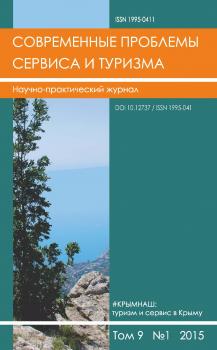Differences in national cultures and unique cultural heritage are among the main drivers of international tourism de- velopment. There is faster growth and more noticeable specialization in this segment of the tourism market. In recent years, there is increased attention to the role of event tourism as an efficient way to engage elements of intangible cultural heritage to the organization of travelers’ leisure, and thus to increase tourist flows while minimizing damage to the environment and the material cultural heritage. The article presents the results of a study conducted in Vladimir region by means of expert interviews and case study. The analysis has shown that a year-round calendar of event tour- ism, based on attracted intangible cultural heritage, contributes to the interest of tourists for the first destination visit and helps to create a basis for increasing the repeat visits share. Moreover, it helps to solve a set of interrelated issues, including inventory and preservation of intangible cultural heritage and to balance the interests of all destination stake- holders (business actors, tourists, residents, governmental and municipal bodies). It is possible to reduce unevenness of tourist flows in time and space, and to overcome the problem of Vladimir-Suzdal Museum Reserve limiting possibilities to serve growing visitors flow without damaging the material cultural heritage included in the UNESCO list.
cultural heritage, event tourism, cultural tourism, tourist destination attractiveness, Vladimir region
1. Baggio R., Sheresheva M.Y. Network approach in economics and management: The interdisciplinary nature. Vest- nik Moskovskogo universiteta. Ser. 6. Ekonomika [Moscow University. Economics Bulletin], 2014, No.2, p. 3-21. (In Russ.).
2. Voyachek O.S., Golovushkina M.V. The place of Russia in the modern tourist market. Sovremennye nauchnye issledovanija i innovacii [Modern scientific researches and innovations], 2014, No.3. URL: http://web.snauka.ru/is- sues/2014/03/31632 (Accessed on May 10, 2016). (In Russ.).
3. Davydenko I.V. Dominant event tourism market. Perspektivy razvitija nauki v sovremennom mire [Prospects for the development of science in the modern world]: Proceedings of the International science-practical conference. Krakow, 2012, p. 97-103. (In Russ.).
4. Sheresheva M.Y. Creation of tourist clusters in the regions of Russia. logistics, 2016, No.6, p. 52-56. (In Russ.).
5. Sheresheva M.Y. The forms of networking in tourism and marketing partnership. Novaja ekonomika i regional’naja nauka [The new economy and regional science], 2015, No.2, p. 25-26. (In Russ.).
6. Del Barrio M.J., Devesa M., Herrero L.C. Evaluating intangible cultural heritage: The case of cultural festivals. City, Culture and Society, 2012, vol.3, No.4, p. 235-244.
7. Du Cros H., McKercher B. Cultural tourism. London: Routledge, 2014. 290 p.
8. Ferdinand N., Kitchin P.J. Events Management. An International approach. Los Angeles; London: Sage Publications, 2012. 376 p.
9. Getz D. Event tourism: Definition, evolution, and research. Tourism Management, 2008, vol.29, No.3, p. 403-428.
10. Gunn C.A., Var T. Tourism planning: Basics, concepts, cases. NY: Routledge, 2002. 442 p.
11. Kerr A. Strange bedfellows: An uneasy alliance between cultural conservation and tourism. Canada: ICOMOS, 1994, vol.3, No.3.
12. Lee A.-L. On Tourist Satisfaction with Cultural Heritage Site - A Case study of the Malacca State. National Sun Yat-sen University, 2009. URL: http://etd.lib.nsysu.edu.tw/ETD-db/ETD-search/view_etd? URN=etd-0816110-141610 (Ac- cessed on May 10, 2016).
13. Ma M.L., Wang Y.M. The Transformation Mode of the Tourism Products of Intangible Cultural Heritage. Journal of Guilin Institute of Tourism, 2008. No.2, p. 029.
14. McKercher B., Ho P.S., du Cros H. Relationship between tourism and cultural heritage management: evidence from Hong Kong. Tourism management, 2005, vol.26, No.4, p. 539-548. DOI:https://doi.org/10.1016/j.tourman.2004.02.018.
15. Nyaupane G.P., Andereck K.L. Visitors to cultural heritage attractions: An activity-based integrated typology. Tourism Culture & Communication, 2014, vol.14, No.1, p. 17-26.
16. Okumus B., Cetin G. Using Local Food in Istanbul’s Marketing as a Tourist Destination. 4th International Interdisciplin- ary Business-Economics Advancement Conference, 2015, p. 73.
17. Rodzi N.I., Zaki S.A., Subli S.M. Between tourism and intangible cultural heritage. Procedia-Social and Behavioral Sciences, 2013, vol.85, p. 411-420. DOI: https://doi.org/10.1016/j.sbspro.2013.08.370.
18. Timothy D.J. Cultural Heritage and Tourism. Bristol, Buffalo, Toronto: Channel View Publications, 2011. 528 p.
19. Wang Y.M., Ma M.L. A Research on the Path of Transforming Intangible Cultural Heritage into Tourism Product: A Case Study of the Real Life of staged Limestone Cave Scenery Yi Shui Li Chuan. Tourism Science, 2007, No.4, p. 008.





